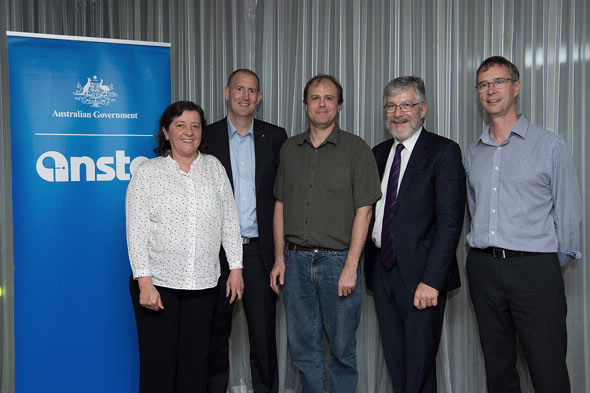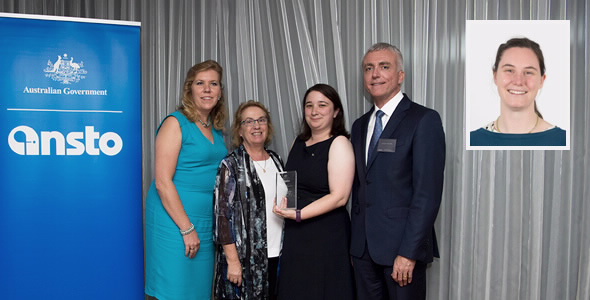Australia’s leading researchers in nuclear science and technology were recognised for their outstanding contribution to science last week at the Australian Nuclear Science and Technology Organisation (ANSTO) Awards in Nuclear Science and Technology presentation dinner.
 |
| (Left to right) ANSTO CEO Adi Paterson, Dr Richard Garrett (who received the Award for Sustained Contribution to ANSTO) and Board Member Prof Andrew Scott AM |
Researchers in early and mid-career stages, along with those who have made an ongoing and sustained contribution to advance Australia’s knowledge in areas including human health and planetary science were recognised at the event, alongside those whose work has enabled innovation through industry partnerships.
ANSTO, as one of Australia’s leading publicly funded research organisations, is home to about 300 researchers, many of whom are among the world’s-best in their field.
 |
| MILGa team members who shared Innovation Award (Front row: left to right) Nigel Lengkeek, Maxine Roberts, Tien Pham (Back row: left to right) Andrew Winthorpe, Angus Bowan, Mark Calvi |
ANSTO CEO Dr Adi Paterson said the contribution of the organisation's researchers to the Australian and international research landscape was significant,
The dedication they have shown to their research, ANSTO and our nation's broader research goals are to be applauded, and it is wonderful to bring everyone together in one place to celebrate their achievements,
Dr Paterson said, "Our people are our greatest asset, and we rightly celebrate their remarkable work."
 |
| SAX/WAX beamline instrument scientist Vesna Samardzic-Boban, Australian Synchrotron Director Andrew Peele, SAX/WAX beamline instrument scientist Nigel Kirby, ANSTO CEO Adi Paterson, and Head of Science Australian Synchrotron Prof Michael James. SAX/WAX team shared Innovation Award |
Dr Paterson said that the calibre of nominations received in the second staging of the awards was tremendous, and the task of the judging panel, including senior ANSTO research leaders and external academics, in selecting the winners was difficult.
"I warmly congratulate the winners of our awards, Helen Maynard-Casely and Helen Brand, the MILGa and SAXS/WAXS Beamline teams, and Richard Garrett and thank them sincerely for their dedication, passion and ongoing commitment."
 |
| (Left to right) ANSTO Group Executive NSTLI Dr Simone Richter, Board Member Carol Holley, Dr Helen Brand (who shared the Early Career Award)and Board Member Prof Andrew Scott AM. Dr Helen Maynard-Casely, who was also a recipient of the award, is shown in inset photograph |
ANSTO Early Career Award winners Helen Maynard-Casely from the Australian Centre for Neutron Scattering at Lucas Heights, and Helen Brand from the Australian Synchrotron in Clayton, work together on planetary materials research.
Maynard-Casely from Loftus and Brand from Brighton East have reinvigorated the use of scattering methods in planetary materials in Australia, to obtain structural data from materials under conditions that mimic the conditions on other planets.
The MILGa and SAXS/WAXS Beamline teams were joint recipients of the George Collins Award for Innovation, named in honour of former Chief of Research who dedicated 28 years of research to ANSTO in numerous roles, and was behind the development of ANSTO's research talent and approach to collaboration today.
The teams, who were presented with their medals by George's wife Mrs Evelyn Collins, were recognised for their work in helping in the research of prostate cancer, and the use of X-rays.
The MILGa team delivered their first clinical dose of a novel nuclear medicine agent for the development of diagnostic and therapeutic tools for prostate cancer, which are now being supplied for clinical trial testing
The SAXS/WAXS Beamline team developed a new way of using high-intensity X-ray beamlines to analyse proteins and liquid samples, to overcome past limitations associated with such experiments and open new research frontiers.
Richard Garrett's recognition, with the Award for Sustained Contribution to ANSTO, acknowledges his leading role in the development, construction and operation of the world-class Australian Synchrotron, at ANSTO's Clayton campus.
The facility accelerates electrons to almost the speed of light, producing an intense light about a million times brighter than the sun which can be used to investigate materials at a sub-microscopic level.
Dr Garrett, who has worked at ANSTO for over 25 years and lives in Barden Ridge, was instrumental in the Australian Synchrotron from its earliest stages, and continues to guide its national and international success.
The Synchrotron enables the discovery and research in areas ranging from medical and life sciences, to advanced materials and engineering, environmental science and synchrotron research methods
Media contact: Phil McCall 0438 619 987
Published: 07/03/2017

